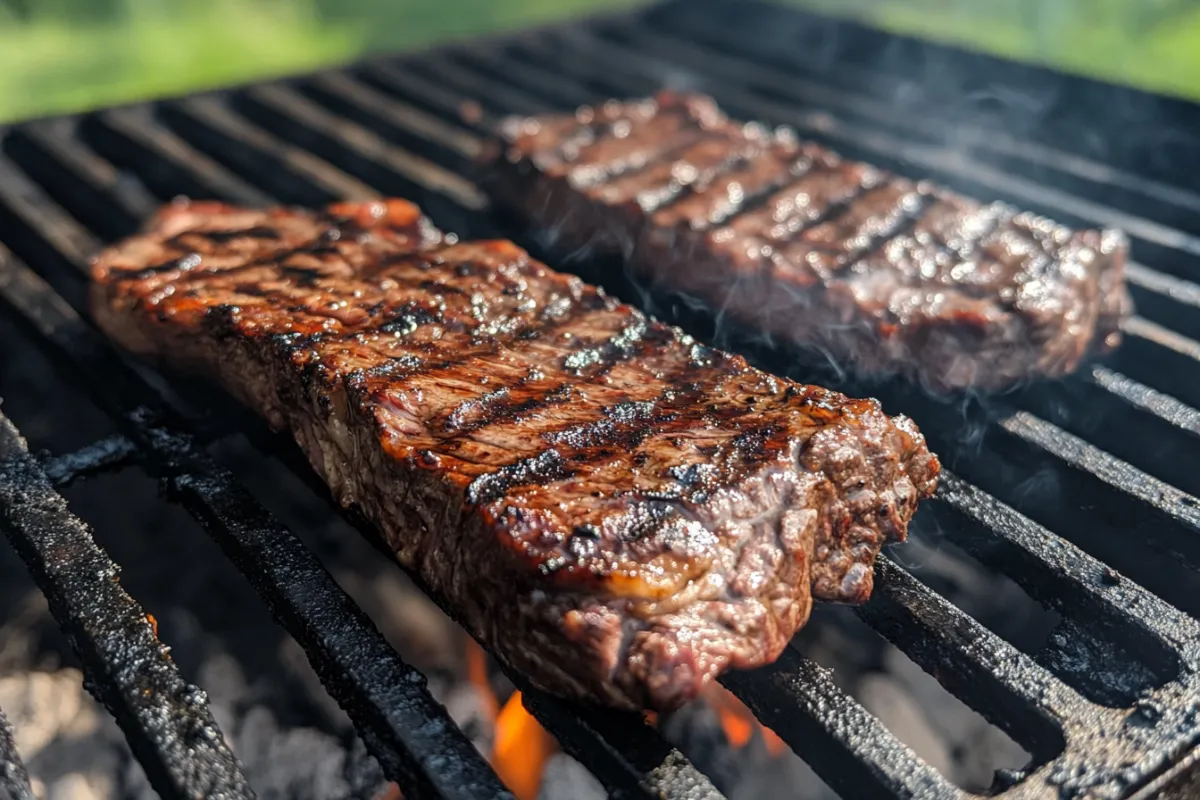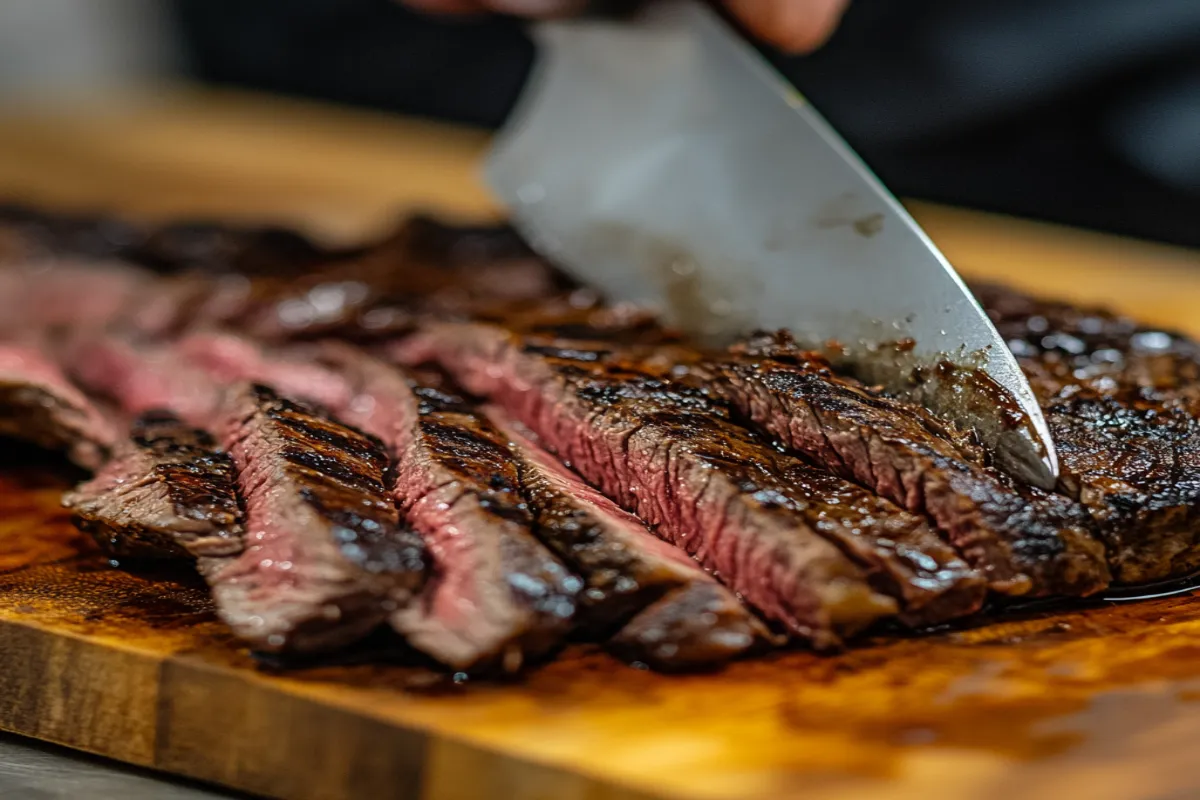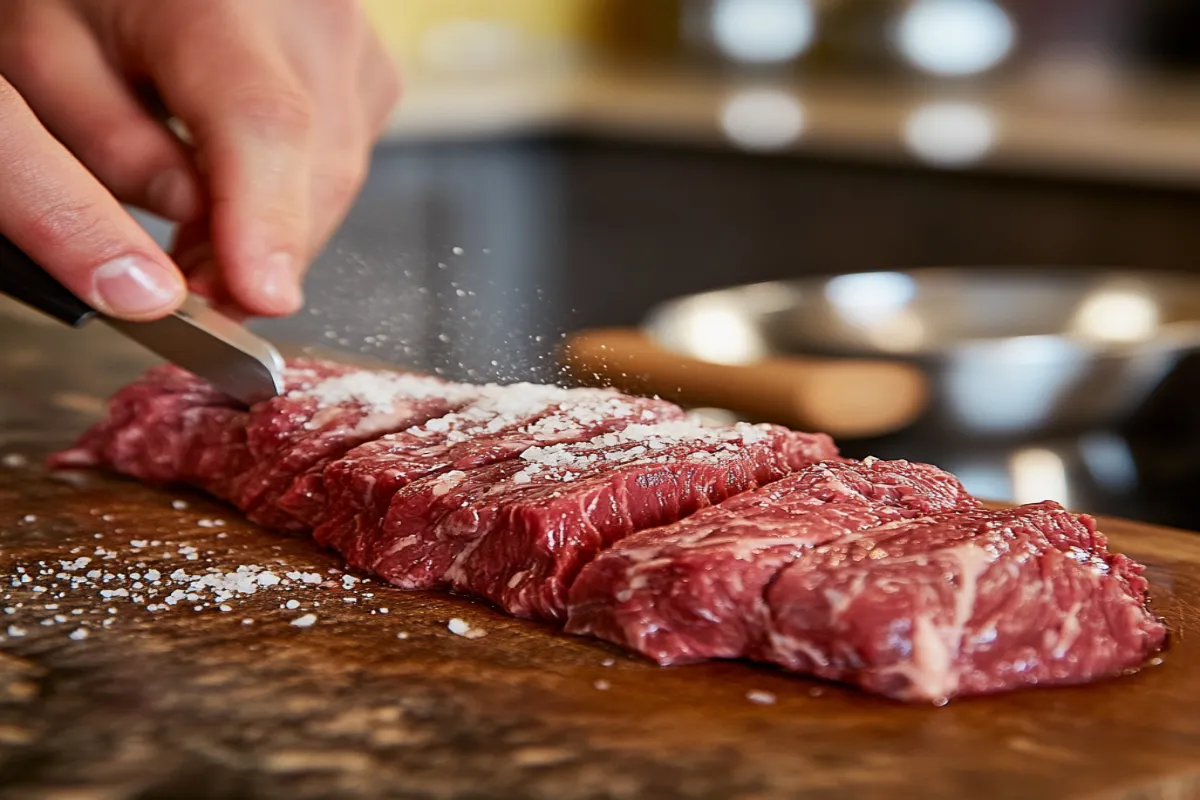If you’re a fan of beef, you may have come across hanger steak, a once lesser-known cut that has steadily gained popularity among chefs and home cooks. Known for its rich flavor and tenderness, this cut of beef is now sought after for its versatility in the kitchen. It’s often referred to as the “butcher’s secret,” as butchers used to keep this cut for themselves because of its superior taste and texture. This article provides everything you need to know about hanger steak—what it is, how it compares to other cuts, how to cook it, and why it deserves a spot in your kitchen.
What is Hanger Steak?
Hanger steak is a beef cut taken from the lower belly of a cow, located between the rib and loin, near the diaphragm. It “hangs” from the diaphragm, which is why it’s called the hanger. This positioning means it doesn’t get much exercise, keeping it tender compared to more active muscle cuts.
For more information about this cut and its anatomical placement, you can read about the diaphragm (meat) on Wikipedia, where hanger steak and similar cuts like skirt steak are discussed in further detail.
Also known as the butcher’s steak or hanging tenderloin, this steak belongs to the flat steak family, which includes other popular cuts like flank steak and skirt steak. What makes it stand out is its marbling and deeply beefy flavor. Although it was once an underrated cut, the hanger steak is gaining popularity due to its richness and versatility.
To learn more about where this cut fits into the beef spectrum, check out the USDA Beef Cuts Chart.
Other Names for Hanger Steak
Given its global appeal, this cut goes by various names across different cuisines. It’s commonly known as:
- Onglet in French cuisine, where it’s frequently featured in bistros.
- Lombatello in Italy, often used in traditional recipes.
- Solomillo de pulmón in Spain, where it’s grilled or served as tapas.
- Hanging tender or hanging tenderloin in the United States, referencing its position near the diaphragm.
These names reflect the cross-cultural appreciation for the rich flavor and unique texture of this steak.
Characteristics
One of the most distinguishing features of this cut is its intense marbling, which enhances its flavor and keeps it juicy when cooked. This steak has a slightly coarse grain but remains tender if cooked properly and sliced against the grain.
The cut consists of a v-shaped muscle with a thick, inedible membrane running through the center, which is typically removed by the butcher before selling. The grain of the hanger steak runs in a particular direction, so slicing against the grain after cooking is essential to ensure a tender bite.
How Hanger Steak Compares to Other Cuts
To truly appreciate the appeal of this steak, it’s helpful to compare it with other popular cuts of beef, particularly those it is often confused with, like flank steak and skirt steak.
Hanger Steak vs. Skirt Steak
Both the hanger cut and skirt steak come from the diaphragm of the cow, but they have notable differences in texture and flavor. Skirt steak has a more pronounced grain and is generally thinner, delivering a slightly stronger, beefier taste. However, it can be chewier if not cooked properly. In contrast, the hanger steak is thicker, has a finer grain, and retains more moisture during cooking, making it a better option for those seeking a tender bite.
Hanger Steak vs. Flank Steak
Flank steak, taken from the abdominal muscles, is leaner and firmer than the hanger cut. . Though flank steak is excellent for high-heat grilling and thin slicing, it lacks the marbling that gives hanger steak its juiciness. As a result, the hanger steak tends to be more tender and flavorful, particularly when cooked to medium-rare.
For another similar cut comparison, check out How to Cook a Bavette Steak: The Ultimate Guide, which compares bavette with hanger steak and other popular cuts.
How to Cook 
This steak thrives on high-heat, quick-cooking methods that bring out its full flavor. Unlike tougher cuts that require slow cooking, hanger steak performs best when seared quickly to develop a flavorful crust while keeping the interior juicy. Here’s how to get the most out of this unique cut:
1. Marination and Preparation
Hanger steak benefits from marinating, especially since it has strong muscle fibers. A marinade that includes acidic elements—such as citrus juice, vinegar, or wine—helps to tenderize the meat while enhancing its natural flavor.
Tips for Marinating:
- Prepare a marinade using ingredients like olive oil, garlic, lemon juice, soy sauce, and fresh herbs.
- Allow the steak to marinate for at least 30 minutes to infuse flavor, but for deeper results, leave it in the refrigerator for up to 12 hours.
- Before cooking, pat the meat dry to ensure a good sear. Too much moisture can prevent the crust from forming.
2. Cooking Techniques
The goal when cooking hanger steak is to sear it quickly over high heat. This technique locks in the juices and forms a beautiful crust. Here are the most effective ways to cook it:
Grilling:
- Preheat your grill to high heat, ensuring it reaches the desired temperature to give the steak a quick sear.
- Place the meat directly over the hottest part of the grill and cook for 3-4 minutes on each side to achieve a medium-rare result.
- The high heat helps create a charred, flavorful crust while keeping the inside tender.
Broiling:
- If grilling isn’t an option, broiling is a great alternative. Preheat your broiler and position the rack about 2-3 inches from the heat source.
- Broil the steak for 3-4 minutes on each side, flipping it only once. This method creates a similar sear to grilling while preserving the interior’s juiciness.
Using a Cast-Iron Skillet:
- For stovetop cooking, use a cast-iron skillet, which retains heat well and provides an even sear. Preheat the skillet until it becomes smoking hot.
- Add a small amount of high-heat oil, such as avocado oil, and sear the meat for 3-4 minutes on each side.
- The cast-iron skillet enhances the caramelization of the steak, resulting in a delicious crust.
3. Resting the Steak
After cooking, allow your hanger steak to rest for 5-10 minutes before slicing. Resting ensures that the juices redistribute throughout the meat, making each bite juicy and tender. Cutting into the steak immediately after cooking can cause the juices to escape, resulting in a drier piece of meat.
How to Properly Slice Hanger Steak

To achieve the best results with this cut, slicing it correctly is key. Always slice against the grain, which refers to the direction of the muscle fibers. Cutting against the grain shortens these fibers, resulting in a more tender and enjoyable texture.
Steps for Proper Slicing:
- Identify the Grain Direction: Observe the lines in the meat to determine the grain’s direction.
- Cut Into Sections: If the steak is large, first divide it into smaller sections for easier handling.
- Slice Against the Grain: Rotate the meat sections 90 degrees and slice thinly across the grain. This technique shortens the muscle fibers, making the steak tender and easy to chew.
The Flavor Profile of Hanger Steak
The hanger steak stands out for its deep, beefy flavor. Thanks to its marbling, the steak has a richer taste compared to leaner cuts, making it a popular choice among meat lovers. Its intense flavor makes it perfect for pairing with bold sauces or spice rubs.
Best Seasonings and Marinades
Simple Seasonings:
- A basic seasoning of kosher salt and freshly ground black pepper can elevate the natural flavors of hanger steak.
- Adding a drizzle of olive oil before grilling or broiling helps develop a crispy, caramelized crust.
Marinades and Sauces:
- This steak pairs beautifully with acidic sauces like chimichurri, balsamic reduction, or garlic butter.
- Herb-based sauces such as pesto also work well to balance out the steak’s rich, beefy flavor.
Spice Rubs:
- For those who prefer bolder flavors, rub the steak with a blend of smoked paprika, cumin, garlic powder, and cayenne pepper. These spices create a flavorful crust that complements the richness of the meat.
Culinary Uses for Hanger Steak
Thanks to its versatility, hanger steak works well in a variety of dishes, from simple grilled meals to more elaborate recipes.
Popular Dishes Featuring Hanger Steak

1. Steak Frites: A French Classic
In French cuisine, hanger steak is a popular choice for steak frites, where the steak is seared and served with crispy French fries. The simple preparation lets the flavor of the steak shine, often paired with a butter-based sauce.
2. Steak Tacos
Tacos are a delicious way to enjoy this beef cut. Marinate the steak with lime juice, garlic, and cilantro, then grill and slice it thinly. Serve with fresh toppings like pico de gallo and avocado crema for a flavorful, satisfying taco.
3. Korean Bulgogi
For an Asian twist, hanger steak works wonderfully in bulgogi. Thinly slice the steak and marinate it in a mixture of soy sauce, sugar, garlic, and sesame oil. Cook the slices quickly over high heat and serve with rice and vegetables for a savory dish.
Using Hanger Steak as a Substitute
It can easily be used in place of other cuts like flank or skirt steak in recipes. Its rich flavor and tender texture make it a versatile substitute in dishes that call for high-heat cooking.
- Substitute for Flank Steak: Use hanger steak in recipes like stir-fry or fajitas for a more tender, juicy result.
- Substitute for Skirt Steak: This cut can replace skirt steak in tacos, grilled dishes, or steak sandwiches, adding extra depth of flavor.
Where to Buy Hanger Steak
Due to its increasing popularity, hanger steak is now more readily available at local butcher shops, larger supermarkets, and online meat suppliers.
Where to Buy:
- Local Butchers: Your neighborhood butcher can often provide high-quality and may offer advice on preparation and cooking techniques.
- Supermarkets: Many supermarkets now carry hanger steak, though availability may vary.
- Online Meat Suppliers: For those seeking the highest quality, consider ordering from online meat purveyors. These sources often specialize in grass-fed or premium cuts.
How to Identify Quality:
- Look for steaks with a vibrant red color and even marbling throughout the cut.
- Ensure the membrane has been removed if purchasing from a supermarket. If not, ask your butcher to take care of it.
Storing Hanger Steak
Proper storage is key to preserving the quality of your hanger steak.
Refrigerating:
- Store fresh steak in the refrigerator for up to three days, properly wrapped to prevent drying.
Freezing:
- To freeze, wrap the steak in plastic wrap and place it in an airtight bag. Frozen hanger steak maintains its quality for up to three months.

